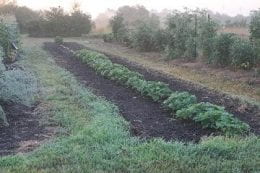Strawberry beds might be done producing for the summer, but that doesn’t mean we can forget them. An August application of nitrogen on spring-bearing strawberries is important in order to increase the number of strawberries produced next spring. Plenty of daylight and warm temperatures during June, July and August promotes the growth of new runners, or daughter plants. As daylight hours dwindle and temperatures grow cooler in September and October, fruit buds for the next year’s fruit crop develop. To get a good berry crop next spring, it is important for strawberry plants to be vigorous during this period of fruit bud development.
fruit bud development.
Nitrogen, applied mid-August, will help promote fruit bud development. A general application rate is ½ to 3/4 pound of actual nitrogen per 100 feet of row. The nitrogen may be in the form of a fertilizer mixture such as ammonium phosphate or 12-12-12, or in a fertilizer containing only nitrogen such as urea or ammonium nitrate. Some specific examples would include:
Iron + (11-0-0) at 6 pounds per 100 feet of row.
12-12-12 at 5.5 pounds per 100 feet of row.
Nitrate of Soda (16-0-0) at 4 pounds per 100 feet of row
Ammonium sulfate (21-0-0) at 3 pounds per 100 feet of row
Urea (46-0-0) at 1.5 pounds per 100 feet of row
By: Cassie Homan






